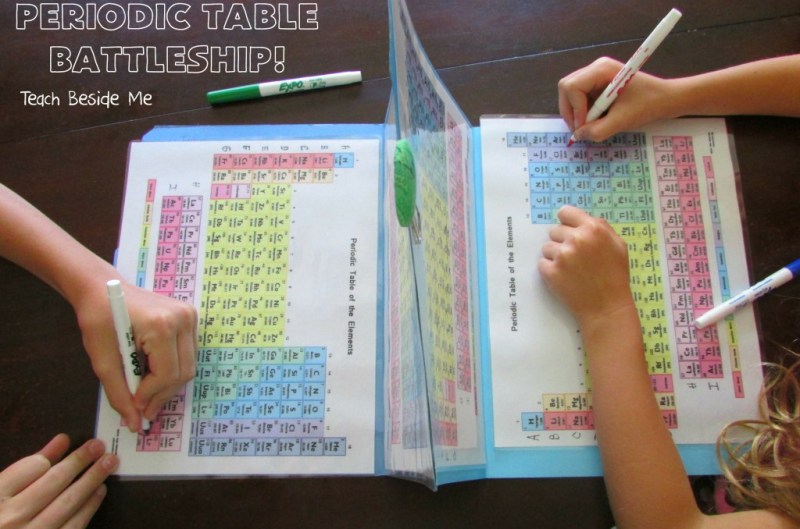Kids these days, they have it so easy. Back in the old days, we learned our elements the hard way, by listening to “The Elements” by Tom Lehrer over and over until the vinyl wore out on the LP. Now, thanks to [Karyn], kids can learn the elements by playing “Battleship” – no tongue-twisting lyrics required.
For anyone familiar with the classic “Battleship” game, you’ll wonder why no one thought of this before. [Karyn]’s version of the game is decidedly low-tech, but gets the job done. She printed out four copies of the periodic table, added letters to label the rows, and laminated them. A pair of tables goes into a manila file folder, the tops get clipped together, and dry-erase markers are used to mark out blocks of two to five elements to represent the ships of the Elemental Navy on the lower table. Guesses at the location of the enemy ships can be made by row and series labels for the elementally challenged, or better yet by element name. Hits and misses are marked with Xs and Os on the upper table, and play proceeds until that carrier hiding in the Actinide Archipelago is finally destroyed.
This is pure genius in its simplicity and practicality, but of course there’s room for improvement. The action-packed video after the break reveals some structural problems with the file folders, so that’s an obvious version 2.0 upgrade. And you can easily see how this could be used for other tabular material – Multiplication Table Battleship? Sounds good to us. And if your nippers catch the chemistry bug from this, be sure to take a deeper dive into the structure of the periodic table with them.
Now, if you’ll excuse me: “There’s antimony, arsenic, aluminum, selenium, and hydrogen and oxygen and nitrogen and rhenium….”
[Via the Adafruit blog]

















This could go further … is the square a salt metal or noble gas?
i was just thinking that, you could play a version of “guess who” with elements instead of people.
“is your element heavier than oxygen?”
salt is not elemental, but a combination of a metal and a non-metal.
Alkali metals, possibly. With which you can make many salts…
Nice! Learn while kicking ass. :D And smart phone App in 3… 2… 1…, because we all know if it ain’t on the phone, it ain’t happening with kids these days….
You beat me to it!
The FIRST thought I had on seeing this was “wonder how many people are now working on a JavaScript version?” :D
For fiendish sorts, the ships have to be sunk by forming a compound or a reaction from hits on the table. Lithium and oxygen for starters, pro points for multiple-hits to produce amino acids.
Everyone will hide out in the noble gasses!
It’s funny, knowledge of the periodic table is given far more weight pedagogically than is reflected by the utility of such by anyone that will go on to make a career in chemistry. While obviously one needs to be familiar with it and what it represents, the fact is not a critical tool for solving real-word problems in the field.
Seems to me the thinking is that solving real-world problems in the field is not the sole goal of fundamental education. Not that this justifies the level of emphasis; I’m just saying that not being directly useful isn’t really an argument for or against anything.
To some extent you are right, but in this case, understanding the relationships of the elements to one another, which is what the table illustrates, once grasped, is far more important than any information that can be gleaned from ability to navigate it with ease. I’m not suggesting it’s not important, but young chemists will get more out of cultivating a deep familiarity of the electrochemical series than they will from one of the periodic table.
now I got the animaniacs stuck in my head! not that that is a bad thing.
I would assume that just becoming familiar with the periodic table is the goal. We’re talking about young students after all – many that won’t pursue a career in chemistry or any type of physical science. For many of these students they would never have had the slightest care of how the elements are arranged (or even what the elements are) and this type of activity forces them to become familiar with that.
I doubt your science teacher ever told you that “selenium is an element”. You probably learned it just by seeing it on the periodic table. And similarly it was probably how you learned that steel or oil were not elements. Very basic stuff that you need to learn in general education.
is an element.
Ahh, crap HTML bromine joke fail.
Trying to use HTML entities to make this work delivers a strange error message … “Invalid security token” … ???
Have any of you ever read the H. Beam Piper short story “Omnilingual”? The ruins of a city on Mars are discovered and an archaeological team is sifting through the stuff, finding tons of books. Problem is they can’t decipher the language. It may as well be Rongorongo because it has no linguistic links to any Earth language.
https://en.wikipedia.org/wiki/Omnilingual
https://en.wikipedia.org/wiki/Rongorongo
Near the end they find the room where the last Martians went to die after their last wind turbine power generator failed. On the wall is a periodic table. Elements are elements so after deciphering the layout they have all the Martian words for the elements, numbers and other data any periodic table would have, no matter what arrangement it’s in.
On our first game of Periodic Table Battleship, our Expo dry erase markers stained our laminate tables/matts. Has anyone come across this? Do your recommend a different brand of marker? Is there something I can put on the laminate to prevent staining?